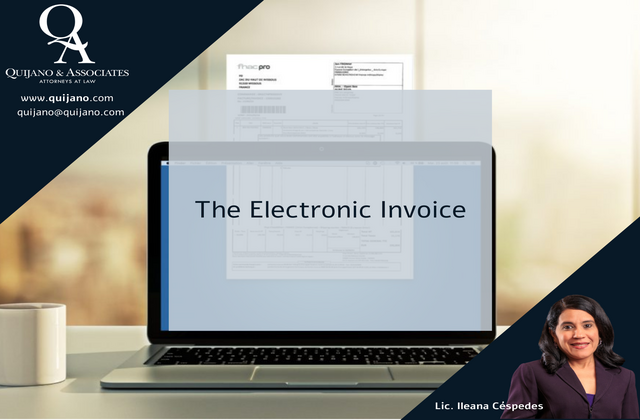The Electronic Invoice

The Panamanian fiscal system requires that any commercial transaction for the transfer of ownership of assets or the collection of fees for services provided be described and recorded in writing as an invoice for tax return purposes, which was issued by means of a fiscal printer, the Directorate General of Taxable Income (DGI) first issued Resolution No. 201-5784 of the 31st of August, 2018 authorizing the use of electronic invoicing by enterprises participating in a Pilot Plan for such purposes.
However, in the light of the various changes that have taken place in economic activities since the Declaration of National Emergency due to the pandemic, and the foreseeable increase in various kinds of activities during the process of recovery of the country, Executive Decree No. 766 of the 29th of December, 2020 was approved to establish the option of electronic invoicing according to a series of procedures, which we have simplified to submit as guidance for our clients within the national territory.
To begin with, not only individuals and legal entities excluded from access to fiscal printers by a resolution of the DGI may now use the electronic invoicing system, but also any individuals or legal entities may do so by simply applying to the DGI for admission to the use of electronic invoices as acceptable documentation for recording their transactions of purchase and sale of assets and their operations as providers of services.
Executive Decree No. 766 of the 29th of December, 2020 defines how and when and for what purposes can electronic invoices be used as “the electronic instrument in XML form, with purely digital existence backing and recording operations involving the transfer of assets and/or services”.
Such documentation must be issued through electronic means and with that form it is valid evidence of commercial operations for taxation purposes, but it must be signed electronically and validated by a Qualified Authorization Provider, whereupon it will be admissible value as evidence. Under the definition provided by Decree 766, electronic operations as credit and debit notes, importation and exportation invoices are admitted as evidence for fiscal purposes.
Generally, the electronic invoice is a digital fiscal document legally valid as evidence of commercial transactions between seller and buyer, signed electronically, whose content and authenticity is admissible evidence. Electronic invoicing has the following advantages:
- It simplifies tax liabilities.
- It fosters electronic commercial activity.
- It reduces costs for users.
- It has positive bearings on the environment.
The main advantage of the electronic invoice for the entrepreneur is the ability to establish an entirely automatic invoicing procedure, which is more convenient for the usual operational strategic procedures because the electronic invoice has the same admissibility as evidence as the invoices issued by the Fiscal Equipment and, therefore, its value as evidence is guaranteed by an electronic certificate issued by a registered service provider duly authorized by the National Directorate of Electronic Signatures of the Public Registry of Panama. It also saves operational costs such as paper, printers, ink, etc.
How can you start using electronic invoices
In order to be able to use electronic invoicing, the taxpayer individual or legal entity has to register as such with the DGI, the actual issuing of electronic invoices has to be authorized by a Qualified Provider of Authorization (PAC), which are legal entities authorized by the DGI to grant such authorizations, or otherwise it has to be issued by the Free Invoicer of the Electronic System of Panama (SFEP). This last system can be used only by:
- Any individual or legal entity requesting the DGI to authorize its use of the Electronic Invoice.
- Any individual or legal entity declared unable to use fiscal equipment, is bound to comply with the provisions of Executive Decree No. 766 of the 29th of December, 2020.
Contents of an Electronic Invoice
- In order to identify an electronic invoice as such, it must have a Sole Code for Electronic Invoicing (CUFE) according to its definition in the technical data sheet (the set of rules, regulations and definitions published and updated in the DGI’s web portal, describing the formats, procedures and standards related to the use of Electronic Invoices).
- Identify the kind of transaction and the general data of the transaction, i.e, identifying the issuer taxpayer issuing the invoice and the party receiving it, as well as other general data such as specifying if it refers to exports, data of fiscal documents referred to, such as credit and debit notes of the taxpayers authorized to discharge the invoice and events therein.
- A description of every object or matter of the documented transaction consisting only in a detail of the products acquired or the services received and/or provided.
- The complementary field of the specific commercial field is the optional field to be used in the event of activities such as purchase and sale of vehicles, medicines and raw materials with a reference to the respective purchase order.
- The complementary field of general commercial use of data such as information about the commercial order, the logistics and the identification of the place of delivery.
- There are fields outside of the scope of electronic invoicing, because they are integrated under the QR code of security printed on the Electronic Invoice Receipt impressed (or CAFE), through which the invoice may be scanned and may also be verified if it has been authorized by the DGI.
Requirements to be fulfilled by enterprises in order to invoice electronically
Besides having an electronic device to produce the invoices, the following requirements must be fulfilled:
- To be duly registered in the DGI, i.e., having an Only Registry of Taxpayers (RUC) and a Digit for Verification (DV), as well as a duly updated description of the activities it engages in.
- Having obtained the digital signature certificate issued by the Public Registry of Panama.
- To adapt its systems in order to be able to produce the invoices according to the specifications of the technical data sheet of the Electronic Invoice System of Panama (SFEP) or proceed to acquire software able to provide such services or to use the web portal developed by the DGI.
- To register for the use of Electronic Invoices through the SFEP portal.
- To inform the DGI that it is no longer going to use the Fiscal Equipment it had been using before up to that date and is to be replaced by electronic invoicing.
Correcting an Electronic Invoice
In the event that the user must correct an electronic invoice already authorized by an Authorization for Use, the user must do so by issuing an electronic credit or debit note through the web services of the Electronic Invoice System of Panama. If it has not been authorized, it may be nullified by registering the given situation.
If some technical problem prevents the issuer from transmitting or receiving a reply to the issuer’s request, the document must be issued in the mode of Contingency Operations according to the following requirements:
- Produce the electronic invoice and its Auxiliary Evidence of Electronic Invoice with the proper information for Contingency Operation.
- Safely store the electronic invoices that have been signed electronically so that they may then be transmitted to a Qualified Authorization Provider.
When the technical problems have been solved, all electronic invoices and other documents issued during the Contingency Operation must be transmitted according to the procedures described in the Technical Data Sheet. If the invoice is rejected, the issuer will have to produce the digital filing of the invoice once more with the same number and then transmit the information again to the DGI or the PAC until the proper Authorization for Use has been obtained. Then, an Electronic Invoice Auxiliary Evidence must be produced showing the correction of the information and finally the correction must be transmitted to the receiver, either by substituting the Electronic Invoice or the Auxiliary Evidence of Electronic Invoice or both.
Closing now, the main purpose of the issue of electronic invoices is that it will enable the DGI to have online access to all information about the transactions of the taxpayers for fiscal purposes.




